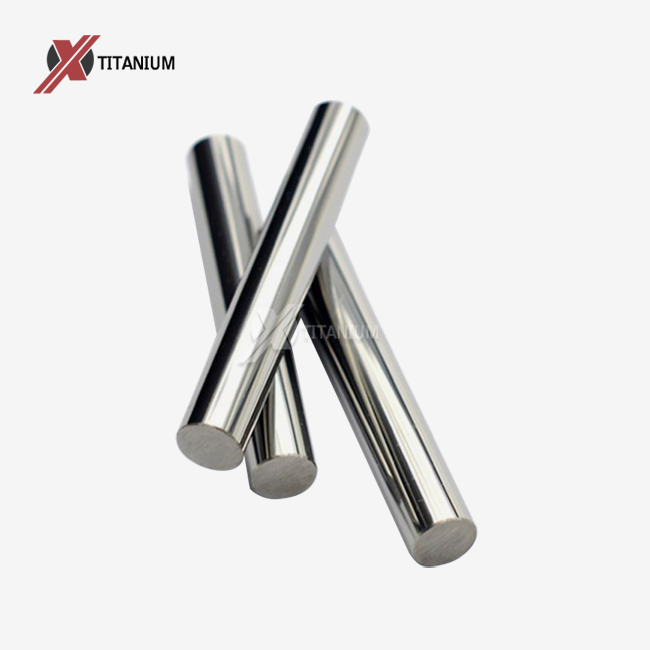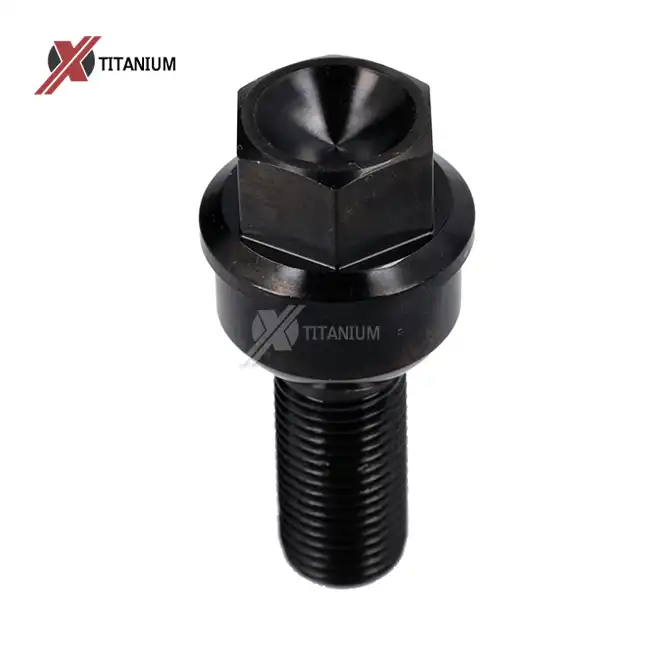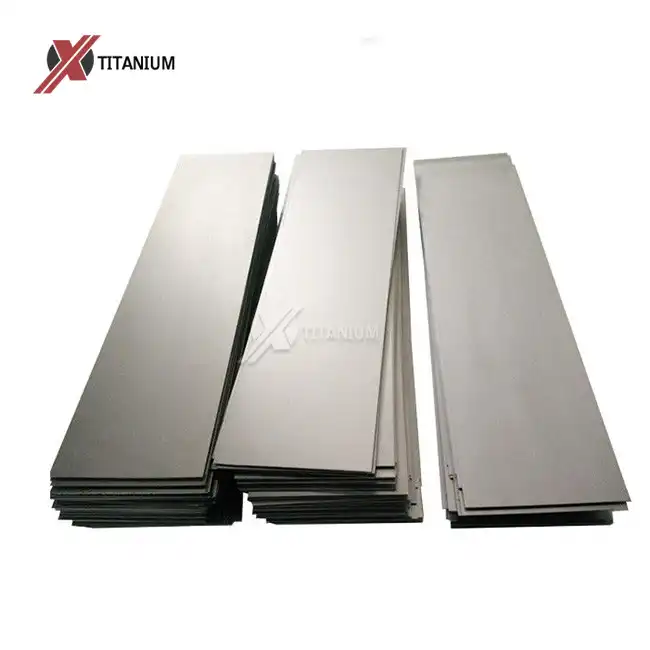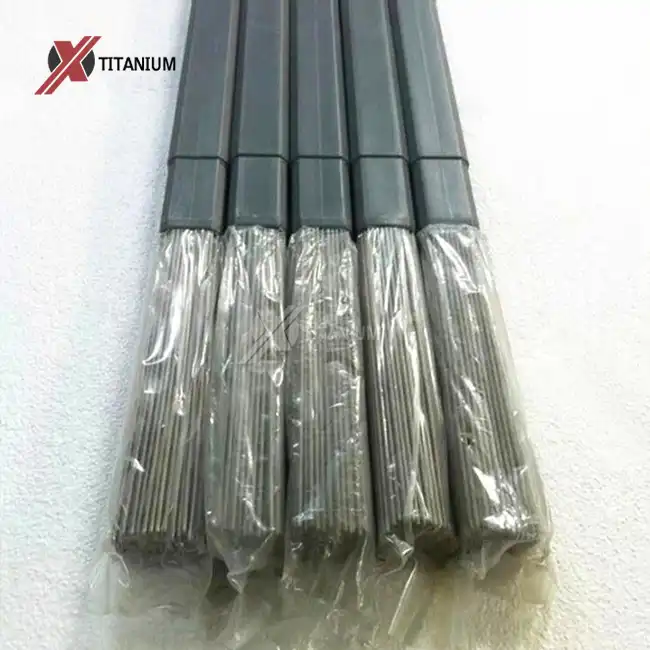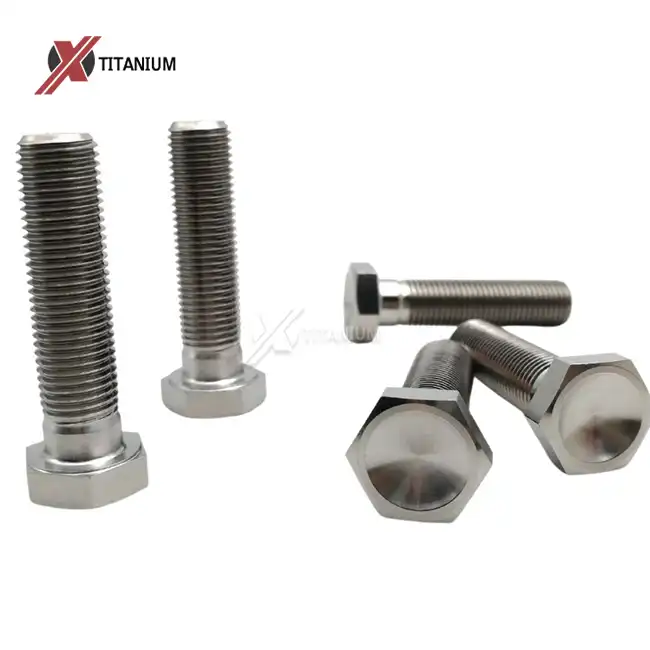Composition and Mechanical Properties: Grade 2 vs Grade 5 Titanium
The composition of Grade 2 and Grade 5 titanium rods plays a significant role in their mechanical properties and overall performance. Grade 2 titanium is composed of nearly pure titanium with minimal alloying elements. This composition results in moderate strength and excellent corrosion resistance. Grade 2 titanium rods typically have a tensile strength of around 345 MPa and a yield strength of 275 MPa.
In contrast, Grade 5 titanium rod, also known as Ti-6Al-4V, is an alloy containing 90% titanium, 6% aluminum, and 4% vanadium. This alloying significantly enhances its mechanical properties. Grade 5 titanium rods boast a tensile strength of approximately 900 MPa and a yield strength of 830 MPa, making them substantially stronger than Grade 2 rods.
Microstructure and Heat Treatment
The microstructure of Grade 2 titanium is predominantly alpha phase, which contributes to its excellent formability and weldability. Grade 5 titanium rod, however, has a more complex microstructure consisting of both alpha and beta phases. This dual-phase structure allows for heat treatment, enabling further optimization of mechanical properties.
Heat treatment of Grade 5 titanium rods can result in various microstructures, including fully lamellar, bimodal, or equiaxed, each offering different combinations of strength, ductility, and fatigue resistance. This versatility in heat treatment options makes Grade 5 titanium rod highly adaptable to specific application requirements.
Density and Weight Considerations
Both Grade 2 and Grade 5 titanium rods are prized for their low density compared to steel. Grade 2 titanium has a density of approximately 4.51 g/cm³, while Grade 5 titanium rod has a slightly lower density of 4.43 g/cm³. This minor difference in density, combined with the significantly higher strength of Grade 5, results in an exceptional strength-to-weight ratio for Grade 5 titanium rod, making it particularly valuable in aerospace and high-performance applications where weight reduction is critical.
Corrosion Resistance and Environmental Performance
Corrosion resistance is a hallmark of titanium alloys, and both Grade 2 and Grade 5 titanium rods exhibit excellent resistance to various corrosive environments. However, there are subtle differences in their performance that can influence material selection for specific applications.
Grade 2 titanium is renowned for its exceptional corrosion resistance, particularly in marine environments and chemical processing applications. It forms a stable, protective oxide layer that provides excellent resistance to saltwater, chlorides, and many acids. This makes Grade 2 titanium rods an ideal choice for seawater desalination plants, chemical reactors, and marine hardware.
Grade 5 titanium rod, while still highly corrosion-resistant, may be slightly less resistant to certain chemical environments compared to Grade 2. However, its superior strength and heat resistance often outweigh this minor difference in many applications. Grade 5 titanium rod performs exceptionally well in oxidizing acids and chloride solutions, making it suitable for use in chemical processing equipment and offshore oil and gas applications.
Temperature Performance
When it comes to temperature performance, Grade 5 titanium rod outshines Grade 2. Grade 2 titanium maintains its properties well up to about 315°C (600°F), making it suitable for many industrial applications. However, Grade 5 titanium rod can perform reliably at temperatures up to 400°C (752°F), with some specialized heat treatments allowing for even higher temperature applications.
This superior heat resistance of Grade 5 titanium rod makes it the material of choice for high-temperature aerospace applications, such as jet engine components and exhaust systems. It also finds use in high-temperature chemical processing equipment where strength and corrosion resistance at elevated temperatures are crucial.
Biocompatibility and Medical Applications
Both Grade 2 and Grade 5 titanium rods are biocompatible, meaning they can be safely used in medical implants and devices. However, Grade 5 titanium rod is more commonly used in medical applications due to its higher strength and excellent fatigue resistance.
Grade 5 titanium rod is widely used in orthopedic implants, dental implants, and surgical instruments. Its high strength-to-weight ratio allows for the creation of lightweight yet durable medical devices. Additionally, the ability to heat treat Grade 5 titanium rod enables manufacturers to tailor its properties for specific medical applications, such as improving osseointegration in dental and orthopedic implants.
Industrial Applications and Manufacturing Considerations
The choice between Grade 2 and Grade 5 titanium rods in industrial applications often comes down to balancing performance requirements with cost considerations. Each grade has its strengths and ideal use cases across various industries.
Grade 2 titanium rods are extensively used in chemical processing industries, particularly in applications requiring excellent corrosion resistance without the need for high strength. They are commonly found in heat exchangers, piping systems, and reaction vessels handling corrosive chemicals. The marine industry also heavily relies on Grade 2 titanium for components exposed to seawater, such as propeller shafts, pumps, and valves.
Grade 5 titanium rod, with its superior strength and heat resistance, dominates in aerospace and high-performance engineering applications. It is crucial in the manufacture of aircraft structural components, engine parts, and fasteners. The automotive industry, particularly in racing and high-performance vehicles, utilizes Grade 5 titanium rods for components like connecting rods, valves, and suspension parts where weight reduction and strength are paramount.
Machining and Fabrication
When it comes to machining and fabrication, Grade 2 and Grade 5 titanium rods present different challenges and considerations. Grade 2 titanium, being softer and more ductile, is generally easier to machine and form. It can be readily welded using conventional techniques, making it a preferred choice for fabricating complex shapes and structures in chemical and marine applications.
Grade 5 titanium rod, while more challenging to machine due to its higher strength, offers excellent machinability compared to many other high-strength alloys. Special tooling and cooling techniques are often employed to efficiently machine Grade 5 titanium components. Welding Grade 5 titanium rod requires more precise control of heat input and shielding to prevent embrittlement, but with proper techniques, it can be successfully welded for various applications.
Cost and Availability
Cost is an important factor in material selection, and there are notable differences between Grade 2 and Grade 5 titanium rods. Grade 2 titanium, being a commercially pure grade, is generally less expensive and more readily available than Grade 5. This makes it an attractive option for large-scale applications where corrosion resistance is the primary requirement.
Grade 5 titanium rod, due to its alloying elements and more complex production process, commands a higher price. However, its superior mechanical properties often justify the cost in applications where performance is critical. The aerospace and medical industries, in particular, find the higher cost of Grade 5 titanium rod acceptable given its exceptional strength-to-weight ratio and biocompatibility.
Conclusion
In conclusion, the choice between Grade 2 and Grade 5 titanium rods depends on the specific requirements of the application. Grade 2 excels in corrosion resistance and is ideal for chemical processing and marine environments, while Grade 5 titanium rod offers superior strength and heat resistance, making it the go-to choice for aerospace, medical, and high-performance engineering applications. Understanding these key differences allows engineers and designers to make informed decisions, balancing performance needs with cost considerations. As titanium technology continues to advance, both grades will undoubtedly play crucial roles in driving innovation across various industries.
At Baoji Chuanglian New Metal Material Co., Ltd., we specialize in producing high-quality Grade 5 titanium rods and other titanium products. With over a decade of experience in titanium processing, we offer unparalleled expertise in manufacturing titanium components for diverse industries. Whether you need Grade 5 titanium rod for aerospace applications, medical devices, or custom engineering projects, our team is ready to provide tailored solutions that meet your specific requirements. For more information about our Grade 5 titanium rod products or to discuss your project needs, please contact us at info@cltifastener.com or djy6580@aliyun.com.
FAQ
What are the main differences between Grade 2 and Grade 5 titanium rods?
Grade 2 is commercially pure titanium with excellent corrosion resistance, while Grade 5 is an alloy with higher strength and heat resistance.
Which grade is better for marine applications?
Grade 2 is typically preferred for marine applications due to its superior corrosion resistance in saltwater environments.
Can Grade 5 titanium rods be used in medical implants?
Yes, Grade 5 titanium rod is widely used in medical implants due to its high strength and biocompatibility.
How does the cost compare between Grade 2 and Grade 5 titanium rods?
Grade 5 titanium rod is generally more expensive due to its alloying elements and complex production process.
References
1. Matthews, A. (2019). "Titanium Alloys in Aerospace Applications: Properties and Processing." Journal of Aerospace Engineering, 32(4), 215-230.
2. Chen, Q., & Thouas, G. A. (2015). "Metallic implant biomaterials." Materials Science and Engineering: R: Reports, 87, 1-57.
3. Lutjering, G., & Williams, J. C. (2007). "Titanium (Engineering Materials and Processes)." Springer Science & Business Media.
4. Donachie, M. J. (2000). "Titanium: A Technical Guide." ASM International.
5. Boyer, R., Welsch, G., & Collings, E. W. (1994). "Materials Properties Handbook: Titanium Alloys." ASM International.
